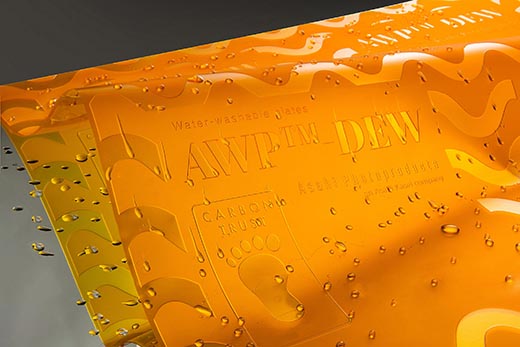Asahi Photoproducts Achieves Carbon Neutral Certification for AWP™-DEW CleanPrint Flexo Plates
Press release from the issuing company

Company partners with the Carbon Trust in pursuing this important sustainability achievement
Tokyo, Japan & Brussels, Belgium. Asahi Photoproducts, a pioneer in flexographic photopolymer plate development, today announced it has achieved Carbon Neutral Certification in partnership with the Carbon Trust for its AWP™-DEW CleanPrint water-washable flexographic plates in compliance with PAS 2060. This certification is renewed on a regular basis; with each renewal period, carbon reduction requirements escalate, with the goal of reducing the actual carbon footprint of the certified product, from sourcing raw materials through packing and shipping the product, its use at the customer site, and its disposition at end of life.
?We are proud to have achieved this important milestone in our sustainability journey,? said Dieter Niederstadt, Asahi Photoproducts Technical Marketing Manager. “We understand the importance of accountability and continuous improvement in carbon footprinting, and we are grateful to the Carbon Trust for their expert guidance and oversight. We look forward to ongoing interaction with the Carbon Trust as we continue our whole-of-company compliance with the carbon management plan that is part of the Carbon Neutral certification process. We are also dedicated to helping our customers leverage this certification in their own carbon footprinting efforts.”
Partnering with the Carbon Trust
The Carbon Trust is an international climate change and sustainability consultancy with the mission to accelerate the transition to a low carbon economy by helping governments, businesses, and organizations to reduce carbon emissions and achieve greater resource efficiency. A leader in environmental footprinting, the Carbon Trust certifies the footprint of products, organizations, and value chains across the globe. In working with a certifying organization such as the Carbon Trust, there is a formal process for achieving certification. It comprises two stages. First, the Carbon Trust works with applicants to establish an accurate measurement of their current carbon footprint; in other words, Carbon Measured Certification, in accordance with the PAS 2050 standard. Unless you truly know where you are starting from, you can’t accurately measure your progress to Carbon Neutrality. It is a stringent and fully documented process. The second part of the process is compliance with the PAS 2060 standard, which is achievement of Carbon Neutral status.
Accountability is Critical
A key element of the Carbon Neutral certification process is accountability, both to ensure actual compliance with the relevant standards and to avoid any appearance of greenwashing. In addition, driving this type of major change in an organization requires changing the mindset of people in research and development, product management and more. “At Asahi Photoproducts,” Dieter added, “we have been producing water-washable flexo plates since 1973 in the form of APR liquid resin plates for corrugated board, still till today the most environmentally balanced solution in flexographic plate making. And today, we have the full support of our parent company, Asahi Kasei, in creating the necessary cultural change to ensure we achieve even more balance in our flexographic products.”
Resolving climate change issues is difficult, and there is a need to accelerate relevant efforts. That is a key factor in Asahi Kasei’s increased drive toward attaining carbon neutrality status for 30% of its operations by 2030 and 100% by 2050. It is the reason Asahi Photoproducts has worked hard to achieve PAS 2060 Carbon Neutral certification from the Carbon Trust for its AWP™-DEW water-washable flexographic plates.
“While our initial certification utilizes carbon offsets due to the fact that our flexographic plates are manufactured using fossil-based raw materials, our ultimate goal is to minimize these offsets as we work hard to make our products even more in harmony with the environment,” Dieter continues. “In addition to offsetting credits, the Carbon Neutral certification also requires the submission of a carbon management plan including clear targets for reduction of the carbon footprint for the AWP™-DEW product life cycle which is audited on a regular basis. If those reduction targets are not met, the certification will expire. This, for those concerned with sustainability, is the beauty of it all. R&D will need to establish completely new milestones, not only related to the graphical and printing performance of the plate itself, but additionally with respect to its CO2 footprint. The certification for us is only a starting point of a long-term journey. It will take us some time to implement those improvements throughout our AWP™ product portfolio. We hope that other market participants will be encouraged to follow our lead here in order to set flexographic printing technology apart from other alternatives, enabling it to become the printing technology of choice for brands and print buyers.”
To learn more about Carbon Neutrality and the process used by Asahi Photoproducts to achieve this certification, download our white paper, Carbon Neutrality: A Goal Worth Pursuing.”
For more information about flexographic solutions from Asahi Photoproducts that are in harmony with the environment, visit www.asahi-photoproducts.com.
- Questions to ask about inkjet for corrugated packaging
- Can Chinese OEMs challenge Western manufacturers?
- The #1 Question When Selling Inkjet
- Integrator perspective on Konica Minolta printheads
- Surfing the Waves of Inkjet
- Kyocera Nixka talks inkjet integration trends
- B2B Customer Tours
- Keeping Inkjet Tickled Pink
© 2024 WhatTheyThink. All Rights Reserved.














